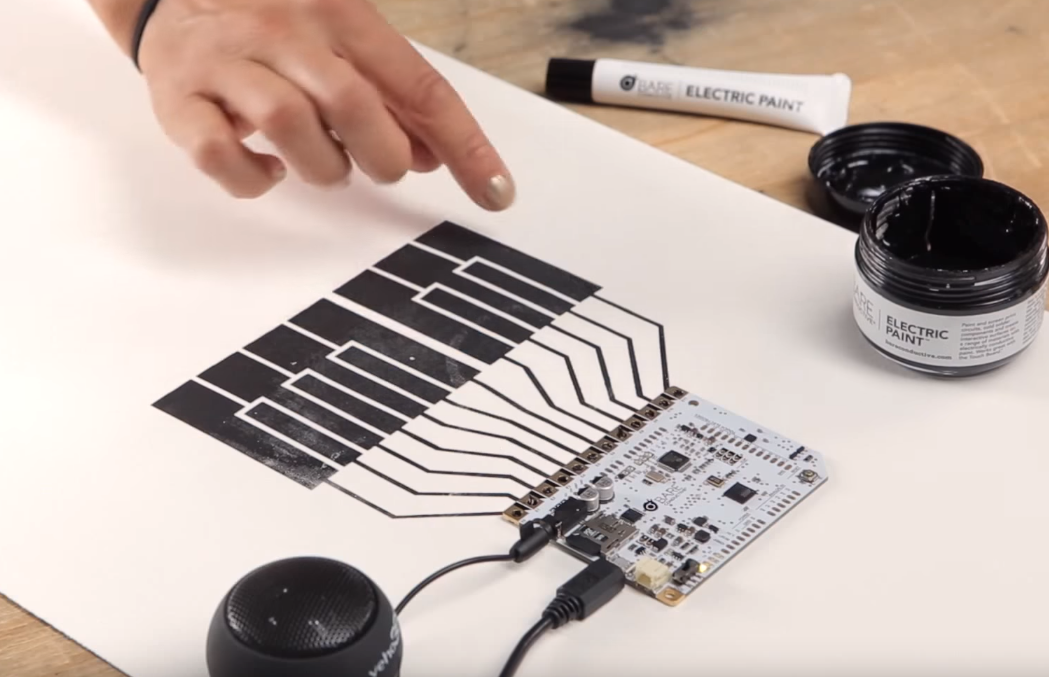
By Max Teodorescu, AspenCore content manager
Linear thinking yields linear results, but that does not necessarily ensure success. True innovation demands nonlinear thinking, which, more often than not, emerges from goal-oriented play and experimentation.
For the design engineer, nowhere does play — aka brainstorming — function as much of a driver of innovation as in the prototype stage. The classic etched PCB has its place in the iterative process that is prototyping, but so, too, does the flexibility of conductive ink.
Conductive ink
Spurred by the growth of low-cost, additive 3D printing, conductive inks have regained attention in recent years despite having existed for quite some time. A 10-year forecast conducted by IDTechEx suggests that the conductive ink market will reach $400M over the next decade.
Per the report: “Printed large-area piezoresistive, capacitive and biosensors are set to become one of the largest constituents of the greater printed electronics industry.”
Brainstorming: the art of problem solving
The use of conductive inks, like 3D printing, is an additive process that does not require highly specialized equipment to rapidly prototype multiple iterations early on, saving both development time and cost. There’s an implicit understanding that designs evolve over time as testing reveals more insight into what actually works.
Conductive inks encourage designers to brainstorm freely and explore new ideas without the hassle of etching or removing excess materials in order to define the conductive trace every time you implement a PCB change. As a result, conductive ink fits into both the traditional linear design process and in one that’s highly agile.
Benefits
The most obvious advantage offered by conductive inks is their ability to create flexible circuit paths on a wide variety of shapes and surfaces beyond the traditional glass fiber reinforced epoxy resin. Inks are available at multiple cost points depending on their resistance and composition. For example, Methode offers ink-jet-printable silver conductive ink that claims up to 200 milliohms per square, whereas London-based firm Bare Conductive offers a more affordable line of ink with 55 ohms per square resistance — fairly high resistance given the $23.50 per 50-ML jar.
Despite differences in underlying properties, most conductive inks are compatible with electrifying nontraditional materials such as paper, plastic, wood, and plaster, expanding the range of possible solutions into nonconventional territory. By freeing circuit prototypes from the confines of virtual space or the hassle of the etching, designers can now re-integrate visual and motor functions back into the prototyping process, freeing their subconscious to play with new ideas.
Limitations
As with all tools, conductive ink has uses and limitations. There are two primary drawbacks. The first is their inherently high resistance compared to that of copper circuit board traces; ink has nearly 20,000 times more resistance for any given trace size than copper. For instance, the Bare Conductive ink has a resistance of 55 ohms per square, whereas a copper trace 50 microns thick has an approximate resistance of about 0.3 milliohms per square.
This isn’t necessarily a bad thing: It’s true that resistance impedes the amount of current a printed trace can reliably carry, but low-current circuits dependent on voltage for their signal suffer no adverse effects. In fact, specific circuits actually require high inline resistance.
Another circumstantial drawback worth considering is that if you perform your prototyping with a non-scalable technology unfit for volume manufacturing, then you’ll have to recreate the prototype with an etched PCB. But once again, that’s not a bad thing; prototyping is an iterative process, not a single-sided task that starts and stops at very fine demarcations. Your first prototype should never be your last.
Identify what assumptions must hold true for this to work
Failing and recreating the prototype helps ensure that you’ve identified all possible constraints early on rather than discovering an incompatibility further down the line when the product already entered into production. Revising a product already in production costs significantly more capital than hedging early in the design process.
Associational thinking
In their book “The Innovator’s DNA: Mastering the Five Skills of Disruptive Innovators,” Jeffrey Dryey, Hal Gregersen and Clayton Christensen observe that innovators think differently from ordinary people. “Their minds excel at linking together ideas that aren’t obviously related to producing original ideas” using a skill called associational thinking.
Conductive ink’s fluidity — both literal and figurative — adds an unconventional process to circuit building that may open up a host of possibilities in how to incorporate electrical circuits into a system design. It may not completely replace copper, but it has its purposes. How far do you think we are from fabricating PCBs solely through additive processes like conductive ink? In what circumstances have you found conductive ink to be useful? Let us know in the comments below.
Advertisement
Learn more about Electronic Products Magazine





